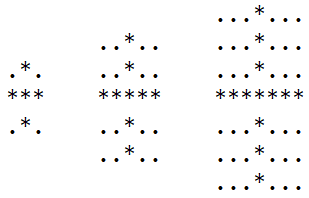Codeforces Round #501 (Div. 3) E(前缀和)
E2. Stars Drawing (Hard Edition)
time limit per test
3 seconds
memory limit per test
256 megabytes
input
standard input
output
standard output
A star is a figure of the following type: an asterisk character '*' in the center of the figure and four rays (to the left, right, top, bottom) of the same positive length. The size of a star is the length of its rays. The size of a star must be a positive number (i.e. rays of length 00 are not allowed).
Let's consider empty cells are denoted by '.', then the following figures are stars:
 The leftmost figure is a star of size 11, the middle figure is a star of size 22 and the rightmost figure is a star of size 33.
The leftmost figure is a star of size 11, the middle figure is a star of size 22 and the rightmost figure is a star of size 33.
You are given a rectangular grid of size n×mn×m consisting only of asterisks '*' and periods (dots) '.'. Rows are numbered from 11 to nn, columns are numbered from 11 to mm. Your task is to draw this grid using any number of stars or find out that it is impossible. Stars can intersect, overlap or even coincide with each other. The number of stars in the output can't exceed n⋅mn⋅m. Each star should be completely inside the grid. You can use stars of same and arbitrary sizes.
In this problem, you do not need to minimize the number of stars. Just find any way to draw the given grid with at most n⋅mn⋅m stars.
Input
The first line of the input contains two integers nn and mm (3≤n,m≤10003≤n,m≤1000) — the sizes of the given grid.
The next nn lines contains mm characters each, the ii-th line describes the ii-th row of the grid. It is guaranteed that grid consists of characters '*' and '.' only.
Output
If it is impossible to draw the given grid using stars only, print "-1".
Otherwise in the first line print one integer kk (0≤k≤n⋅m0≤k≤n⋅m) — the number of stars needed to draw the given grid. The next kk lines should contain three integers each — xjxj, yjyj and sjsj, where xjxj is the row index of the central star character, yjyj is the column index of the central star character and sjsj is the size of the star. Each star should be completely inside the grid.
Examples
input
Copy
6 8 ....*... ...**... ..*****. ...**... ....*... ........
output
Copy
3 3 4 1 3 5 2 3 5 1
input
Copy
5 5 .*... ****. .**** ..**. .....
output
Copy
3 2 2 1 3 3 1 3 4 1
input
Copy
5 5 .*... ***.. .*... .*... .....
output
Copy
-1
input
Copy
3 3 *.* .*. *.*
output
Copy
-1
Note
In the first example the output
2 3 4 1 3 5 2
is also correct.
这个题有两个版本 easy跟hard
easy版本数据范围为100*100,这个显然就是暴力枚举每个*的店,往四个方向扩展,打上标记,最后看是否存在不被打上标记的“*”即可。
hard版本数据范围为1000*1000,easy的暴力方法显然不可行。
我们可以这么考虑,对于一个"*"的点,他的上下左右四个位置的最大扩展长度是跟他旁边的点有关系的,那么,可以用前缀和的方法计算出每个点的l,r,u,d。
在更新点的时候,我们可以采用a[l]+1,a[r+1]-1的方法来更新,最后加起来,就可以得到哪些点被覆盖了。
#include
#define mp make_pair
#define fir first
#define se second
#define ll long long
#define pb push_back
using namespace std;
const int maxn=2e5+10;
const ll mod=1e9+7;
const int maxm=1e6+10;
const double eps=1e-7;
const int inf=0x3f3f3f3f;
const double pi = acos (-1.0);
int n,m;
char str[1010][1010];
int vis[1010][1010];
vector,int> > v;
int l[1010][1010],r[1010][1010],u[1010][1010],d[1010][1010],cnt[1010][1010],cnt1[1010][1010];
int main(){
scanf("%d %d",&n,&m);
for (int i=1;i<=n;i++)
scanf("%s",str[i]+1);
for (int i=1;i<=n;i++){
for (int j=1;j<=m;j++){
if (str[i][j]=='.') continue;
else{
if (str[i][j-1]=='*')
l[i][j]=l[i][j-1]+1;
else l[i][j]=0;
}
}
}
for (int i=1;i<=n;i++){
for (int j=m;j>=1;j--){
if (str[i][j]=='.') continue;
else{
if (str[i][j+1]=='*')
r[i][j]=r[i][j+1]+1;
else r[i][j]=0;
}
}
}
for (int j=1;j<=m;j++){
for (int i=1;i<=n;i++){
if (str[i][j]=='.') continue;
else{
if (str[i-1][j]=='*'){
u[i][j]=u[i-1][j]+1;
}
else u[i][j]=0;
}
}
}
for (int j=1;j<=m;j++){
for (int i=n;i>=1;i--){
if (str[i][j]=='.') continue;
else{
if (str[i+1][j]=='*'){
d[i][j]=d[i+1][j]+1;
}
else d[i][j]=0;
}
}
}
for (int i=1;i<=n;i++){
for (int j=1;j<=m;j++){
if(str[i][j]=='*'){
int Min=min(min(l[i][j],r[i][j]),min(u[i][j],d[i][j]));
if (!Min) continue;
v.pb(mp(mp(i,j),Min));
int L=j-Min;
int R=j+Min;
int U=i-Min;
int D=i+Min;
cnt[i][L]++;
cnt[i][R+1]--;
cnt1[j][U]++;
cnt1[j][D+1]--;
}
}
}
for (int i=1;i<=n;i++){
for (int j=1;j<=m;j++){
cnt[i][j]+=cnt[i][j-1];
}
}
for (int j=1;j<=m;j++){
for (int i=1;i<=n;i++){
cnt1[j][i]+=cnt1[j][i-1];
}
}
for (int i=1;i<=n;i++){
for (int j=1;j<=m;j++){
vis[i][j]=cnt[i][j]+cnt1[j][i];
}
}
for (int i=1;i<=n;i++){
for (int j=1;j<=m;j++){
if (str[i][j]=='*'&&!vis[i][j]){
printf("-1\n");
return 0;
}
}
}
printf("%d\n",(int)v.size());
for (int i=0;i